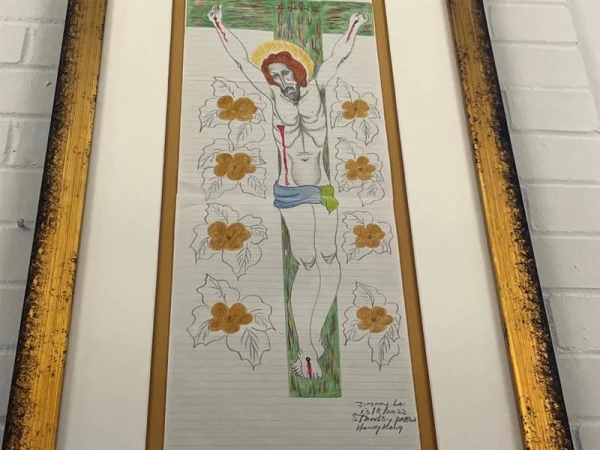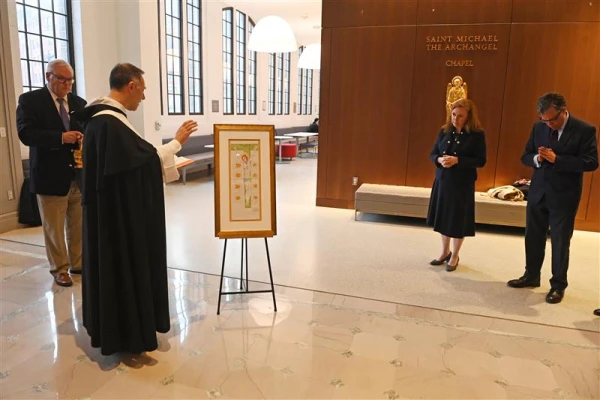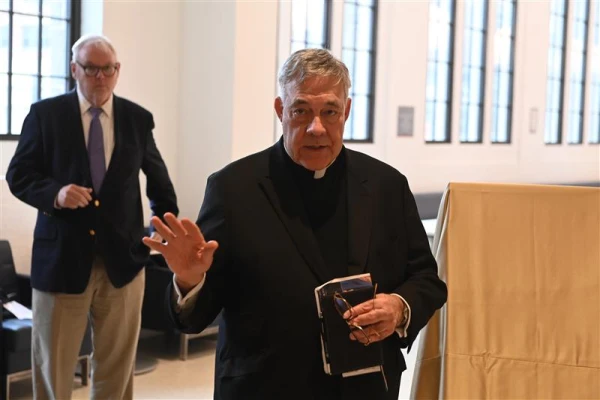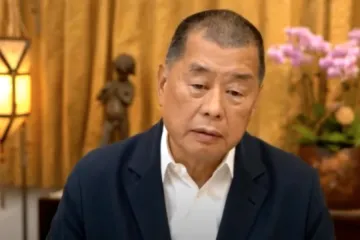Washington, D.C. Newsroom, Feb 23, 2024 / 14:35 pm
The Catholic University of America (CUA) in Washington, D.C., has installed a drawing of the Crucifixion by imprisoned Hong Kong Catholic and pro-democracy activist Jimmy Lai.
Father Robert Sirico, a supporter and friend of Lai’s, said during the installation ceremony on Thursday that the sketch is a testimony “not just of Jimmy’s struggle but the struggle of all people of Hong Kong” and “all of the people of China, who will, by faith, resist [oppression].”
The large drawing depicts Christ on the cross flanked by eight orange flowers. It was created by Lai in prison, where, according to Sirico, he has been kept in solitary confinement for close to 1,500 days.

The picture was blessed by university chaplain Father Aquinas Guilbeau. It is now on permanent display by the St. Michael the Archangel Chapel in Catholic University’s Busch School of Business.

Who is Jimmy Lai?
A successful entrepreneur, newspaper owner, Catholic, and outspoken critic of the Chinese Communist Party (CCP), Lai has been in a Hong Kong prison since 2020 for his pro-democracy and free speech advocacy.
The activist, a convert to Catholicism, was originally arrested in August 2020 under that year’s controversial national security law, which was passed by China’s communist-controlled government. The law sharply curtailed free speech in Hong Kong in an effort to quash what the Chinese Communist Party considered subversion and sedition in the separately administered region.
The plaque below Lai’s drawing at Catholic University explains that he “cites his Catholic faith as the basis for his refusal to be silenced or flee to save himself from arrest.”
Sirico said that the Hong Kong activist willingly chose to give up his comfortable, affluent life by resisting the CCP and refusing to leave Hong Kong. Although Hong Kongers have for years enjoyed a greater degree of freedom than that found in mainland China, that is now quickly changing as Chinese officials crack down on the region.
“If I go away, I not only give up my destiny, I give up God, I give up my religion, I give up what I believe in,” Lai said in 2020. “I am what I am. I am what I believe. I cannot change it. And if I can’t change it, I have to accept my fate with praise.”
Sirico told CNA that Lai sees his imprisonment as a way of joining in Christ’s passion on the cross. He said that the drawing should serve as an inspiring reminder that the “blood of the martyrs is the seed of the Church.”

In prison, Sirico said that Lai has devoted himself to religious reading and prayer. He has also begun creating religious drawings, mostly pictures of the Crucifixion, like the one now on display at Catholic University.
(Story continues below)
A symbol of resistance
CUA has been a vocal supporter of Lai in previous years. In 2022, the university awarded Lai an honorary degree.
Dr. Peter Kilpatrick, Catholic University’s president, told CNA that Lai “represents resistance to real oppression” and that he “represents freedom.”
Kilpatrick said that he hopes students will look at the drawing and learn about Lai and his resistance in Hong Kong and realize that “there are still people in the world who are willing to fight for the truth and who are willing to fight for freedom.”
“I see freedoms being denied all around the world,” Kilpatrick said. “In 2024, we may have to fight harder … not just in Hong Kong, but perhaps right here in the United States, for freedom to worship as we should and must, for the freedom and the dignity of the human person, which is under assault.”
Chen Guangcheng, a world-renowned Chinese human rights activist known commonly as the “barefoot lawyer,” was also at the dedication ceremony. He told CNA that he came to show his support for Lai.
“Jimmy Lai is a good person,” Guangcheng said. “He used his media to see the truth; that is why the CCP persecuted him.”
Guangcheng urged Americans to do more in support of freedom in Hong Kong and mainland China.
“I think if the Western people and government stand with them, the situation still can change,” he said.






